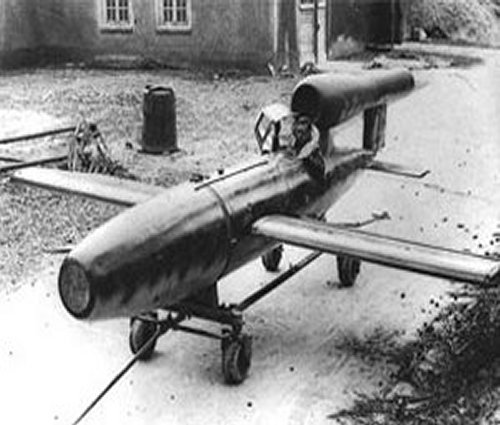
In Service: 1944 to 1945
First Flight: 28 October 1942 Manufacturer: Fieseler Number built: 30,000 plus
Type: Air-to-Surface Manned Missile Crew: 1 man Length: 7.9 m Wingspan: 5.3 m Diameter: m Weight: kg Engine: 1 × Argus As 109-014 pulse jet engine producing up to 300 kg of thrust Maximum speed: 645 km/h Range: 370 km Warhead: 850 kg Amatol 39 Fuze: Launch Platform: He 111 Operators: Luftwaffe Variants: Fieseler Fi 103 Fieseler Fi 103R R-1 R-II R-III R-IV Other: Missiles Articles:
The Fieseler Fi 103R (Reichenberg) was World War 2 piloted version of the V-1 flying bomb these were intended to be suicide missions. The idea came from Hanna Reitsch, world famous woman pilot and Otto Skorzeny, although this idea was scorned upon. It was still pursued and various aircraft types were considered for possible adaption as piloted missiles, but it was decided to convert Fieseler Fi 103 to a piloted version. The operational model was the Reichenberg IV and its conversion from the standard V-1 flying bomb was extremely simple. The basic Fieseler Fi 103 fuselage was divided into six compartments, housing. The magnetic compass, the explosive warhead. The fuel tank, two circular compressed air bottles, and the autopilot and the height and range setting controls and Servo mechanisms controlling the rudder and the elevators. The conversion to Reichenberg IV included the putting in a small cockpit in front of the engine. The instrument panel comprised of an arming switch, a clock and air speed indicator and altimeter and a turn and blank indicator, gyrocompass, flight controls were of the conventional stick and rudder bar type, and the pilot was accommodated by a plywood bucket seat with padded headrest. A single piece hood, which incorporated an armoured glass windscreen. The cockpit occupied the space taken in the pilotless version by the compressed air bottles, and the piloted version was provided with only one compressed air bottle. This being housed in the aft compartment normally occupied by the missiles autopilot. The Reichenberg IV was intended to be carried to the operational area beneath an He 111 bomber, in theory, the pilot was intended to jettison the cockpit canopy, and then bale out after aiming is aircraft at the target, but it was calculated that his chance of survival was little better than one in a hundred. To release the canopy. It was necessary to operate a lever on the port side of the cockpit, at the estimated approach speed 645 km/h. This method of jettisoning the canopy would prove impractical. The training for the Reichenberg IV was carried out by KG 200. In any event, after Werner Baumbach took over command of KG 200 and in October 1944. A the entire programme was dropped in total. 175 Fieseler Fi 103 missiles had been converted other Reichenberg program, but none had been used operationally.
The Warplanes of the Third Reich. ISBN-10: 0385057822 German Aircraft of the Second World War. ISBN-10: 0370000242 Hitler's Luftwaffe. ISBN-10: 051718771X For a complete list of sources
|
| |||||||||||||||||||||||||||






